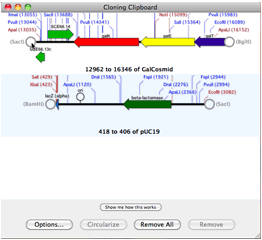
By default, nucleic acid sequences are converted into GenBank text file format while protein sequences are converted into GenPept text file format. Using MacVector for analysis of DNA and protein sequences - Weill Cornell Medicine Events Using MacVector for analysis of DNA and protein sequences Yariv Houvras, Assistant Professor of Cell and Developmental Biology, will demonstrate how his lab leverages MacVector for experimental design and analysis. An easy way to export a Vector NTI database molecule to an external file is to select it in the Vector NTI explorer and drag it to the Windows desktop or to a Windows folder. Other text file format output options include EMBL (nucleic acid only), SWISS-PROT (protein only), and FASTA (nucleic acid or protein), all of which can be read by any version of MacVector. By default, Vector NTI saves nucleic acid sequences in GenBank format and protein sequences in GenPept format when the File->Save As->Save As File option is used to save individual sequence files (an alternate approach is the File->Molecule Operations->Export option). If you are using aversion of MacVector earlier than 10.6, or if you prefer to export your files from Vector NTI first, then you can export (Save As) your sequence files from Vector NTI then open them in MacVector. You can perfectly apply the quality, style, colors, and grains of the most famous films rolls to your digital photos with DxO FilmPack, a simple and efficient tool based on innovative technology. Photography educator Joseph Linaschke shows how DxO FilmPack recreates the look of over 80 legendary film stocks, giving you endless creative possibilities in your digital photos. DxO FilmPack Getting started with DxO FilmPack for Mac. Combine many original renderings with filter, vignetting, blur, texture, frame, or light leak effects to give your photos a. DxO FILMPACK Analog and creative film rendering software Rediscover the style, the colors, and the grain of legendary analog films, faithfully thanks to DxO’s exclusive calibration process. The new DxO ColorWheel is a fantastic new color adjustment tool that you can use to select color ranges from eight separate channels, including orange and purple. This Mac download was scanned by our antivirus and was rated as safe.ĭxO PhotoLab 3’s new HSL (Hue, Saturation, and Luminance) Tool is an exciting and superbly visual way to manage color that can help you produce more creative and natural-looking images. The size of the latest installer available for download is 295.2 MB. This Mac app was originally created by Life Technologies. Vector NTI Express for Mac is included in Education Tools. Vector NTI software is a completely integrated suite of sequence analysis and design tools that help you manage, view, analyze, transform, share, and publicize diverse types of molecular biology data, all within one graphically rich analysis environment. The current versions are v11.5.1 for Windows/PCs and v7.1 for Macs, but only supporting Mac OS X v10.3 (Panther).Features create, annotate, analyse, and share DNA/protein sequences perform and save BLAST searches design primers for PCR, cloning, sequencing or hybridisation experiments plan cloning and run gels in silico align multiple protein. Vector NTI is a bioinformatics software package. Explore 21 apps like Vector NTI, all suggested and ranked by the AlternativeTo user community. Popular free Alternatives to Vector NTI for Windows, Mac, Linux, Web, Chrome OS and more. The most popular version among the program users is 1.2. Commonly, this application's installer has the following filename: vectorntiexpressinstallwinmacpersonal1.2.0.dmg. Overall sequence similarity with the mouse protein is shown on the right.Vector NTI Express 1.2.0 for Mac can be downloaded from our software library for free. The percent similarity of the SAM domains and other regions to the corresponding regions of the mouse protein is shown. (D) Schematic comparison of the amino acid sequences for mouse, rat, human, chick and zebrafish mr-s proteins. Branch lengths reflect the mean number of substitutions per site. Amino acid sequences were analyzed by the neighbor-joining method in MacVector 7.2. (C) Phylogenetic tree of SAM domain-containing proteins. The sites that were targeted for mutagenesis are indicated by arrows. Conserved amino acid residues are shown with a dark shadow and functionally similar residues are shown with a light shadow. (B) Alignment of SAM domain sequences for SAM domain-containing proteins.

The underline indicates a putative polyadenylation termination signal. Boxed amino acids are the SAM domain sequence and the dashed box indicates a putative nuclear localization signal. (A) mr-s nucleotide and amino acids sequences. Mr-s nucleotide and amino acid sequences.


 0 kommentar(er)
0 kommentar(er)
